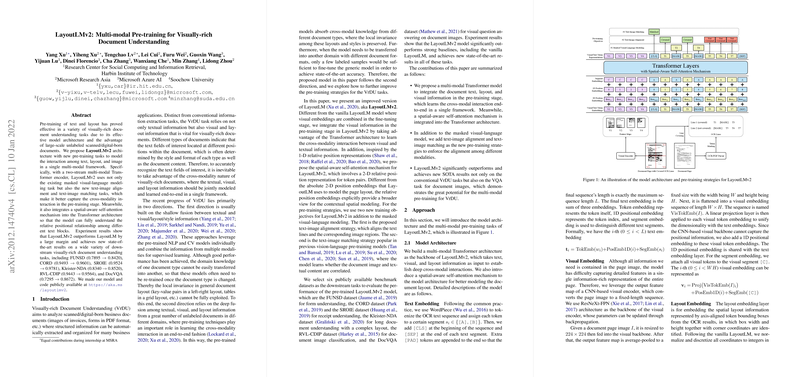Analyzing LayoutLMv2: A Multi-Modal Transformer for Document Understanding
The paper under consideration presents LayoutLMv2, an advanced architecture designed specifically for visually-rich document understanding (VrDU). Developed as a successor to the initial LayoutLM model, LayoutLMv2 integrates multi-modal pre-training strategies to effectively capture the interaction among text, layout, and image data using a two-stream Transformer encoder. This multi-modality approach aims to improve performance across a broad spectrum of document analysis tasks.
Model Architecture and Innovations
LayoutLMv2 differentiates itself from its predecessor by embedding vision information directly within the pre-training phase, rather than deferring it to later stages. This is facilitated through a novel spatial-aware self-attention mechanism within a robust Transformer architecture, optimizing classifier performance in document parsing by more adeptly representing the spatial layout of documents.
The architecture divides input into textual, visual, and layout embeddings. It further models the intrinsic spatial properties of documents using 2-D relative positioning, enhancing prior absolute representation methods. This enables the encoding of nuanced document structure levels, such as text block relationships.
Pre-training Strategies
LayoutLMv2 introduces two key pre-training tasks in addition to Masked Visual LLMing (MVLM). The Text-Image Alignment (TIA) task aims to synchronize text regions with corresponding visual elements, which is crucial for parsing documents with overlapping content. Additionally, the Text-Image Matching (TIM) task ensures a holistic alignment between document text and image, mitigating input discrepancies. These tasks enrich cross-modal pre-training, which subsequently feeds into improvements in the understanding of document semantics.
Experimental Evaluation and Results
The evaluation undertaken on six benchmark datasets demonstrates substantial improvements over baseline models and the original LayoutLM, confirming the efficacy of LayoutLMv2's innovative multi-modal integration. On various tasks such as form understanding (FUNSD), receipt understanding (CORD and SROIE), long document parsing (Kleister-NDA), document classification (RVL-CDIP), and document-based VQA (DocVQA), LayoutLMv2 achieved state-of-the-art results.
Notably, numerical results from the experiments show marked performance enhancements, such as the increase in F1 scores from 0.7895 to 0.8420 on FUNSD and accuracy boosts on RVL-CDIP from 0.9443 to 0.9564, underscoring the model's improved generalizability across document varieties.
Implications and Future Work
The strong numerical results highlight LayoutLMv2's enhanced capabilities in cross-modal document understanding, setting a precedent for future document intelligence systems. The integrated model building, which involves multi-modal embedding and spatial understanding, offers a robust framework for exploiting a wide array of document types with varying formats and complexities.
Going forward, the research suggests further exploration into architectural nuances and pre-training tasks to broaden LayoutLMv2's applicability across different languages and document languages, emphasizing a potential expansion into multilingual contexts. Such developments could leverage the foundational work established by LayoutLMv2 to address even broader challenges in global document processing and create frameworks that are more resilient to variations in document layout and language diversity.
Overall, LayoutLMv2 serves as an exemplary progression in the field of document AI, providing a comprehensive approach to tackling the intricacies of visually-rich document understanding through an effective integration of textual, visual, and spatial modalities.
